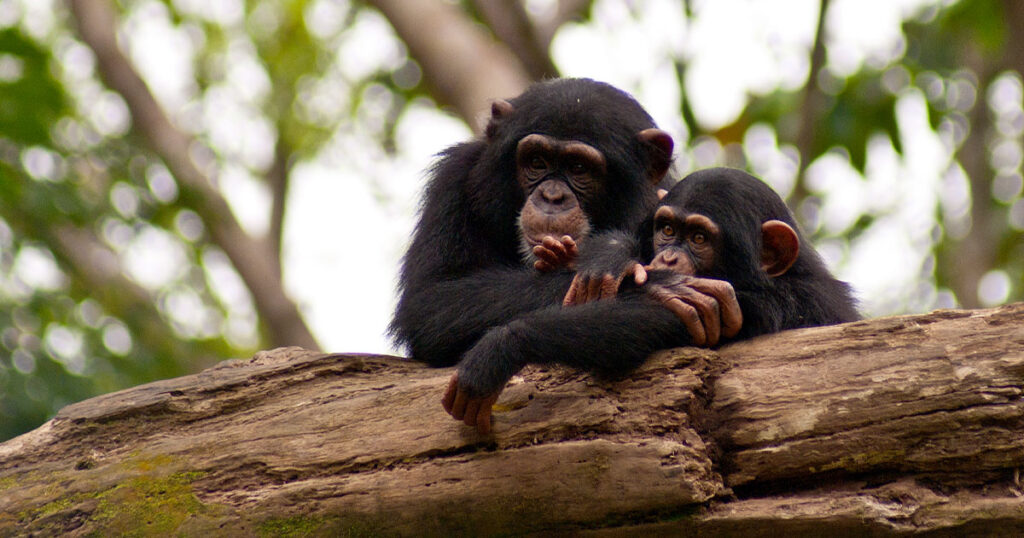
Playing Possum: How Animals Understand Death by Susana Monsó; Princeton University Press, 264 pp., $29.95
Tahlequah gave birth to a daughter in July 2018. The infant lived for only half an hour, but for 17 days, across more than 1,000 miles, Tahlequah would not let her baby go. The mother carried her infant’s corpse halfway across an ocean, balancing it on her snout to prevent it from sinking—a feat all the more impressive since, as an orca, Tahlequah had no hands, and her newborn calf weighed hundreds of pounds. The story of the bereaved orca went viral, inspiring poems, essays—and debates about how, or even whether, animals understand death.
The study of this provocative topic is a new field, known as comparative thanatology, and the subject of philosopher Susana Monsó’s new book, Playing Possum. The discipline traces its origin, Monsó tells us, to another, equally moving incident. In 2008, at a rescue center in Cameroon, an elderly chimp named Dorothy died. To show the other 16 resident apes what had happened, two staffers slowly pushed a wheelbarrow containing Dorothy’s corpse past the apes’ enclosure. The normally noisy, active chimps stared at the body in solemn silence. A photo published in National Geographic prompted a number of researchers to pool observations of other animals’ reactions to death, launching this new field of inquiry.
Comparative thanatology nestles within another young branch of study: the philosophy of animal minds, Monsó’s field of expertise. Until relatively recently, some scientists and philosophers were loath to admit that animals even had minds. Scientific journals initially rejected publishing Jane Goodall’s groundbreaking 1960 observations that chimps used tools (the first animals other than humans reported to do so). Editors accused her of anthropomorphism because she named her study animals rather than numbering them like rocks.
Today, those editors would be criticized for their anthropocentrism—the false assumption that humans alone possess thoughts, feelings, and intrinsic value. Monsó points out that now “there is a huge and growing quantity of studies in comparative psychology that show that many nonhuman species are capable of making inferences, remembering the past, anticipating the future, planning, innovating, adapting to changing circumstances, and many other behaviors that in us require some form of thinking.” One after another, animals have crossed many Rubicons supposedly separating humans from the rest of animate creation.
Do other animals have a concept of death? What does it really mean to understand it? And how can we know what animals may be mentally experiencing in these circumstances? Sometimes animals’ reactions to death—like those of Tahlequah and Dorothy’s chimpanzee comrades—look so much like ours that it seems impossible to conclude they aren’t grieving, much in the same way we do. And why shouldn’t they? Placental mammals share 90 percent of our DNA.
But at times, behavior may be misleading. Burying the dead, for example, was long held to be unique to Homo sapiens. Until recently, when careful reexaminations of excavated skeletons and archaeological records proved otherwise, not even our closest relatives, the Neanderthals, were thought to have done so. Yet ants (as well as bees) systematically carry away and often bury their dead. Ants will also come to the aid of endangered sister members of their colonies. (Male ants do little else than fly and mate; females do not help them when they are hurt.) Monsó describes an experiment in which researchers trapped ants under sand with nylon snares. Other ants diligently dug in the sand and pulled on the victims’ legs to get them out. When that didn’t work, they chewed through the nylon thread to free them. Rather than thinking and feeling, the ants seemed to be “offering a pre-programmed response to a chemical stimulus,” writes Monsó. Struggling ants give off a chemical call for help; dead ants give off a different odor, from oleic acid. Drop some of the latter on a live ant, and her comrades will carry her away to the ant graveyard—despite her vigorous protestations.
By the same token, animals that behave in ways unlike us in the presence of death may be misunderstood or overlooked. Monsó describes a German shepherd who ate chunks off his deceased human’s face and neck—despite the presence of a nearby bowl half-full of dog food. There have been more than a few such incidents in coroners’ reports. Yet, Monsó notes, comparative thanatologists pay no attention to this interesting and not uncommon reaction. Why? The answer is what Monsó calls “emotional anthropocentrism”—which she importantly defines as “presupposing … the only way of emotionally reacting to death is the human way.”
We find the German shepherd’s menu choice here unsettling. Most humans don’t eat the faces off their dead, but that doesn’t mean the dog didn’t love its owner or wasn’t upset by the death. By licking its owner’s face, the dog was probably trying to revive him, and was surely disturbed when that failed, Monsó writes. Anxious dogs frequently self-soothe by nibbling and gnawing, explaining many a shredded rug and chewed shoe. And often, as veterinary surgeons know well, dogs swallow what they have chewed.
Because we don’t like death, we humans turn our backs to it. Though every human dies, it is rare for people in the developed world (apart from combat military and medical professionals) to watch someone do it. Monsó wisely reminds us that animals have a lot more experience. Most wild animals die before their first birthday, often in front of a parent. Predators have to cause other animals to die; prey animals regularly witness the death of others of their species.
Other animals’ understanding of death may be different from ours, but perhaps theirs is, in some ways, wider and deeper. This riveting book—often surprisingly uplifting, sometimes even funny—will enhance and expand our understanding of how other minds may apprehend one of life’s greatest mysteries.

